Origins
Symbols

A history of NATO stamps
Since the early 1950s, NATO Allies have issued postage stamps to commemorate key events in the history of the North Atlantic Treaty Organization, including the Alliance’s anniversaries, the accessions of member countries and the inauguration of new NATO Headquarters.
NATO’s first stamps were issued by Portugal and the United States in 1952, to celebrate the third anniversary of NATO’s founding. More recently, Allies have created special stamps to welcome Finland and Sweden as new NATO member countries, and to celebrate the Alliance’s 75th anniversary.
Here is a selection of NATO postage stamps covering more than seven decades of peace and security.
1952 – NATO’s third anniversary

Portugal was the first NATO Ally to produce a special stamp representing the Alliance. Shortly before NATO’s third anniversary, the Portuguese national post commissioned artist Jaime Martins Barata to create a design highlighting the transatlantic bond between Europe and North America. The stamp also commemorated a historic meeting of the North Atlantic Council in Lisbon in February 1952, where Greece and Türkiye joined NATO in its first round of enlargement.

The United States produced its own NATO stamp soon after. For NATO’s third birthday on 4 April 1952, the White House issued a 3-cent stamp featuring a torch of liberty above the North Atlantic Ocean and three core aims of the Alliance: peace, strength and freedom. Charles R. Chickering of the Bureau of Engraving and Printing designed this NATO stamp, based on a sketch provided by the US State Department. President Harry S. Truman autographed sheets of the stamp for presentation to the other NATO Heads of State and Government.
1953 – NATO’s fourth anniversary

For the Alliance’s fourth anniversary, Italian stamp maker Vittorio Grassi designed a commemorative stamp using the photogravure technique, in which an image is etched into a copper plate using a photographic chemical process. Printed in sky blue and orange, as well as a darker blue and violet, the stamp again symbolised the transatlantic bond, depicting a rainbow connecting Europe and North America. Four million copies of this stamp were issued throughout 1953.
1954 – NATO’s fifth anniversary
For NATO’s fifth anniversary, both Greece and Türkiye created collections of commemorative stamps.

The Greek Airmail Postal Service designed a series of illustrations featuring ancient art and mythical figures, including an Olympic torchbearer, a coin from Ancient Greece and a statue of the goddess Athena. The Athena stamp was particularly relevant for NATO – the goddess of war and wisdom, Athena represents the importance of both military might and political diplomacy to NATO’s success as a defensive alliance. All three stamps also featured a plane to represent the Airmail Postal Service.

The Turkish National Post chose to depict the unity of the NATO Allies and the strength of the transatlantic bond with three different illustrations: a compass and a map of the Northern Hemisphere (left); a crescent moon and 14 stars over the globe, representing the 14 NATO Allies at that time (centre); and a tree with 14 branches (right).
1959 – NATO’s 10th anniversary
To celebrate 10 years of NATO, a record number of Allies designed anniversary stamps.
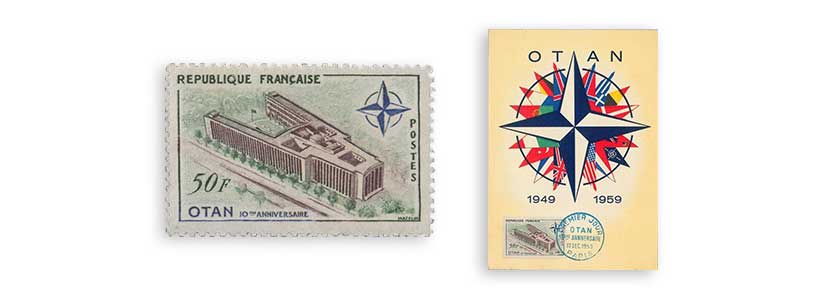
France, which had been producing themed stamps for the member countries of the European Coal and Steel Community (an early precursor to the European Union) since 1956, created a NATO stamp highlighting the then-15 Allies. Designed by the Prix de Rome award-winner Charles Mazelin, the stamp features a detailed illustration of the NATO Headquarters, which was located in Paris at that time. While France was the only country to ultimately adopt the design, its idea inspired similar proposals from other regions.


Belgium, the Netherlands and Luxembourg collectively developed a Benelux stamp with the help of their national post companies. The design was created by Sem Hartz, a well-known Dutch artist who specialised in copper engraving.

Canada used the globe and a dove of peace to represent the unbreakable bond between Europe and North America in a stamp designed by Ephrum Philip Weiss.

Italy celebrated NATO’s 10th anniversary with a classic design, with the NATO compass over the North Atlantic Ocean. The stamp was designed by Luigi Gasbarra. Approximately 15 million copies were produced.

Portugal commissioned the surrealist artist Cândido Costa Pinto to reimagine the commemorative stamp issued in 1952, using key images like a dove and an anchor to symbolise the maritime connection of Allies across the Atlantic Ocean.

The US Postal Service created a simple 10th anniversary stamp in classic NATO blue, designed by artist and illustrator Stevan Dohanos.
1962 – Greece and Türkiye’s 10th anniversary of NATO membership
In 1962, Greece and Türkiye issued postage stamps celebrating 10 years since their accession to NATO.

Greece created stamps again showcasing art from antiquity, including Ancient Greek warriors in various poses. These stamps also marked the NATO Ministerial meeting that took place in Athens on 3-5 May 1962, including at the Zappeion Building (bottom).
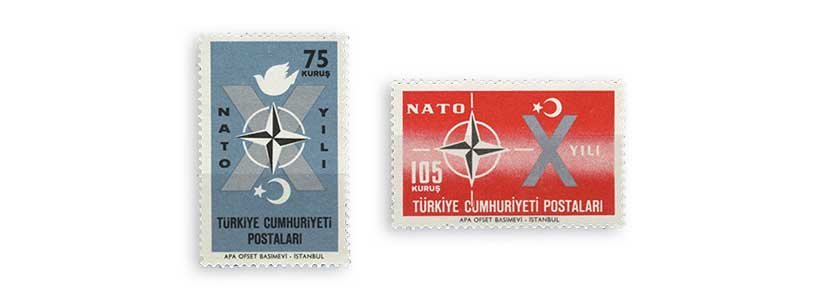
Türkiye opted for a simpler design, with a large X to represent the 10th anniversary in Roman numerals, a dove representing peace, the Turkish star and crescent, and the NATO compass.
1964 – NATO’s 15th anniversary

Türkiye marked NATO’s 15th anniversary by issuing 500,000 stamps with two different designs. The stamps featured NATO’s compass and a wheat stalk with 15 leaves, representing the then-15 NATO Allies and 15 years of peace and security.
1967 – Luxembourg hosts North Atlantic Council meeting

Luxembourg hosted a Ministerial Meeting of the North Atlantic Council in June 1967, the first such NATO meeting to be held in the country. With characteristic national modesty, Prime Minister Pierre Werner welcomed delegates to the meeting, noting that: “The hospitality we shall be offering to our friends and Allies may lack the polish of the great Western capitals but it will be all the more friendly and eager.” The commemorative stamp depicts the building in which the meeting took place.
1968 – Iceland hosts the Reykjavik Ministerial

Iceland also hosted a NATO Ministerial Meeting in its capital city, welcoming NATO Allies to Reykjavik in June 1968. To commemorate this event, the country created a special ink stamp for envelopes featuring the NATO compass.
1969 – NATO’s 20th anniversary
Ahead of NATO’s 20th anniversary, NATO’s Director of Information suggested that all Allies should issue a commemorative stamp celebrating this milestone. As such, 1969 was an outstanding year for the production of NATO stamps.
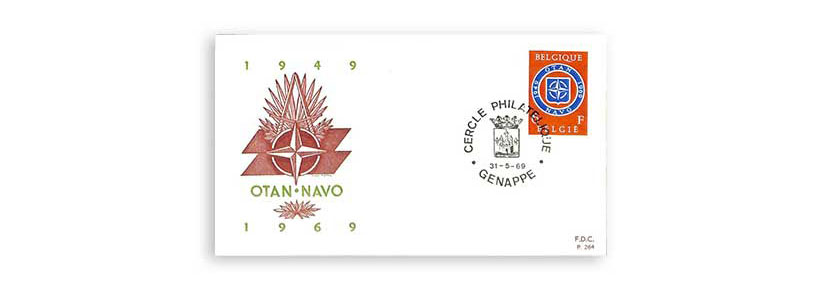
As NATO commemorated the anniversary at its new Headquarters in Brussels, its new host country Belgium commissioned artists Jean Malvaux and Samuel Louis to create a stamp using the Alliance’s emblem. The Belgian stamp went on sale at all post offices throughout the country on 2 June 1969.

Greece chose to mark two decades of NATO with two hand-drawn stamps featuring motifs of Ancient Greece. The first stamp depicts an Attic shield on which a helmet is represented. The second features a formation of hoplites (soldiers from Ancient Greek city states who were primarily armed with spears and shields) going into battle while a flautist plays a paean behind them.

For its 20th anniversary stamp, Luxembourg created a simple red design with the NATO compass and a clear message: “NATO – twenty years of security”.

Türkiye produced two stamps for the 20th anniversary, both including the NATO compass. One features a stylised dove of peace. The other shows 15 stars circling the north of the globe, representing the 15 NATO Allies at that time.

The United Kingdom created its first NATO stamp in 1969, when the British Forces Postal Service invited artists to submit their artwork. The winning design, from graphic designer Philip Sharland, features a flag composed of the different Allied national flags stitched together.
1972 – Türkiye’s 20th anniversary of NATO membership

In 1972, Türkiye celebrated its 20th anniversary of accession to NATO with a commemorative stamp. The Ajans-Turk Matbaasi printing house, which had secured a Guinness World Record for publishing the first embossed stamps in the world, created a design with two harmonious peace doves resembling the Turkish crescent, a percussion instrument traditionally used by military bands.
1974 – NATO’s 25th anniversary
NATO’s 25th anniversary was a major milestone for the Alliance, with Allied Heads of State and Government gathering in Brussels for the second-ever NATO summit.
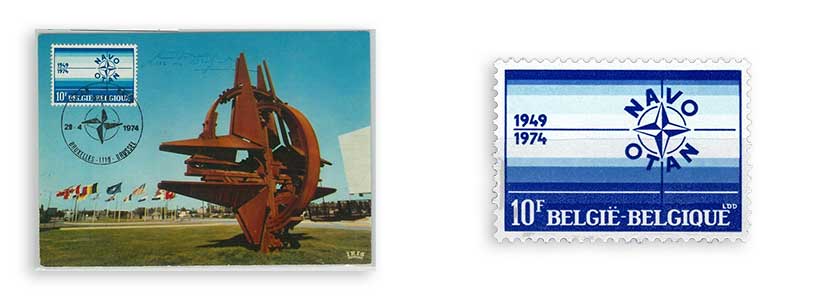
Belgium produced a minimal 25th anniversary stamp, featuring the NATO compass and the Alliance’s signature blue colour. The stamp was designed by Jean Malvaux and Luc De Decker, and had a print-run of 3.5 million copies.

The Netherlands also created a blue stamp for the 25th anniversary, designed by Frans Smits. The stamp includes some familiar symbolic elements (a shield with the NATO compass, representing the defensive power of the Alliance) but also some novelty: the bird on the stamp is not a dove of peace, but actually a seagull, representing the country’s centuries-long seafaring tradition and the importance of NATO’s maritime domain.
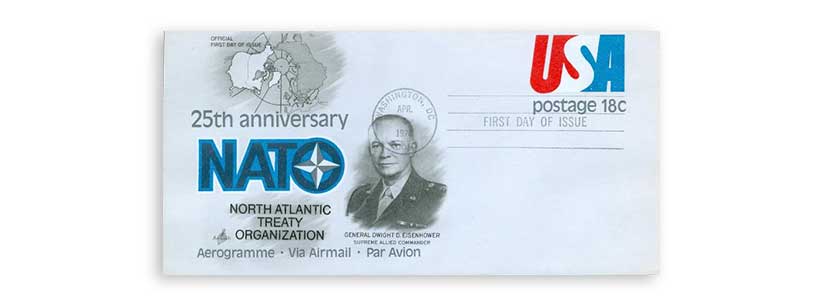
The United States created a 25th anniversary airmail envelope featuring an image of General Dwight D. Eisenhower, who served as NATO’s first Supreme Allied Commander.
1979 – NATO’s 30th anniversary
A number of Allies created stamps to mark NATO’s 30th anniversary in 1979.

Belgium again commissioned graphic artist Jean Malvaux to design a commemorative stamp. Malvaux took inspiration from the NATO star sculpture, designed by Belgian architect Raymond Huyberechts, which stands in front of NATO Headquarters in Brussels. More than 2 million stamps were issued.
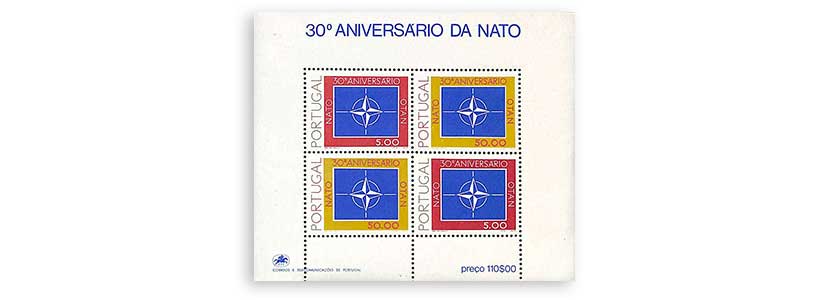
The Portuguese Mail Post used a minimalist design for its own 30th anniversary stamp, featuring the Alliance’s blue flag with the NATO compass.
1980 – Germany’s 25th anniversary of NATO membership

In 1980, Germany celebrated 25 years as a NATO member. The country highlighted this milestone by commissioning graphic artist and illustrator Holger Börnsen, who had been designing stamps for the German Federal Post Office since the early sixties, to produce a design featuring the NATO and Allied flags. More than 20 million copies of the stamp were issued.

1989 – NATO’s 40th anniversary

Denmark’s 40th anniversary stamp put the NATO compass in the spotlight, with a neat blue and white design. The stamp was designed by Ole Bering. Almost 6 million copies were printed.

To celebrate NATO’s 40th birthday, the Netherlands made a ribbon out of the NATO flag and the then-16 Allies’ national flags. The stamp was designed by the Dutch artist and actress Marte Röling, and more than 12 million copies were issued throughout 1989.

Türkiye’s 40th anniversary NATO stamp featured a dove of peace and the NATO compass.
1997 – Spain hosts the Madrid Summit

To commemorate the 1997 NATO Summit in Madrid, the Spanish national post created a stamp featuring the Cibeles Fountain, an iconic monument that stands in front of Madrid City Hall. The stamp had a print-run of 2.5 million copies.
1999 – Czechia, Hungary and Poland join NATO
Shortly before NATO’s 50th anniversary on 4 April 1999, Czechia, Hungary and Poland joined the Alliance. To highlight this important moment in post-Cold War history, the three Central European countries issued three stamps on the date of their accession: 12 March 1999.

Czechia’s accession stamp focuses on a close-up of the NATO compass logo. It was designed by Bohumil Šneider and Zdeněk Ziegler. Over 4 million copies were produced.

Hungary’s accession stamp features an outline of the country, an image of the Hungarian Parliament Building in Budapest, and the Hungarian tricolour from the national flag leading towards the NATO compass. It was designed by Dudás László.

Poland’s accession stamp, designed by Jacek Konarzewski, show the Polish flag next to Allied national flags, with the NATO compass above. It had a print-run of almost 3 million copies. Konarzewski also designed a stamp showing the NATO star sculpture at NATO Headquarters, with the Polish flag superimposed above Allied national flags.
1999 – NATO’s 50th anniversary
Multiple Allies produced stamps in 1999 to celebrate 50 years of NATO.

Belgium launched a collection of stamps showing its contribution to the Alliance’s deterrence and defence, including military vehicles and equipment in different domains. The series of stamps had several designers, including Fernand Domange, Myriam Voz, Thierry Martin, Antoine Roels, Roland Goeleven and Christian Louis.

Canada’s 50th anniversary stamp depicts the NATO flag forming out of the national flags of the 19 NATO Allies at that time. The stamp symbolically represents the 50 years of peace that NATO had brought to its members – the 1949 side of the stamp shows dark skies and lightning when the Allies are standing alone, whereas the 1999 side of the stamp shows blue skies and sunshine when the Allies are united under one NATO banner. Approximately 7 million copies were printed. It was designed by Bonnie Ross and Fraser Ross.

Denmark created a motif containing two fighter jets flying in the direction of the number 50, which doubles as a compass. It was designed by Arne Kühlmann, Bo Linnemann and Philip Ytournel Rasmussen.

Germany’s 50th anniversary stamp has a simple design, showing the compass and ‘NATO’ in blue block letters. It was designed by Paul Effert and had a print-run of 20 million copies.

Luxembourg’s 50th anniversary stamp shows the NATO compass sculpture in front of the North Atlantic Ocean. It was designed by Jacques Doppée.
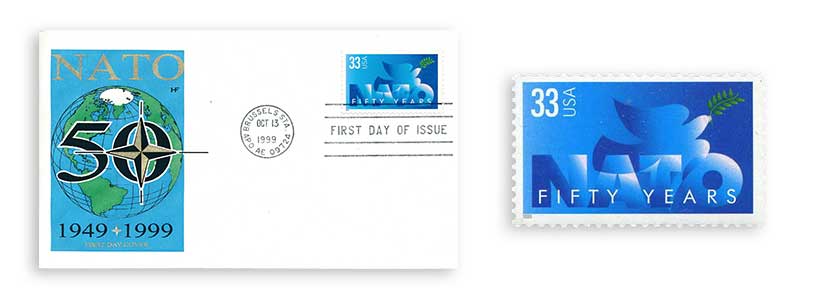
The United States issued a 33-cent stamp designed by graphic designer and exponent of the postmodern graphic arts movement Michael Cronan. This stamp had a massive print-run of more than 44 million copies.
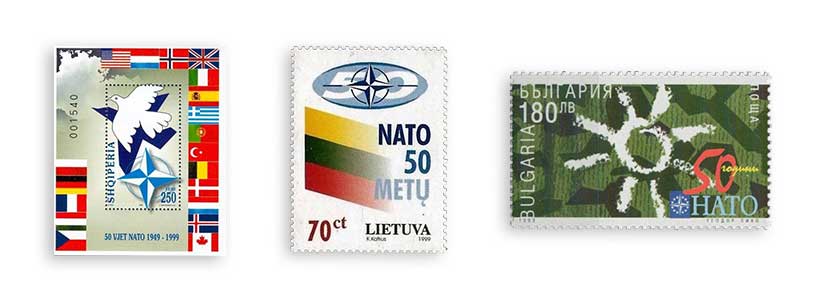
Interestingly, some countries that were not NATO members but aspired to join the Alliance also designed national stamps to commemorate the Alliance’s 50th anniversary. This included Albania (top left), whose stamp depicts a dove with the shadow of a fighter jet (designer: S. Taçi); Lithuania (top right), whose stamp combines the Lithuanian national flag and the NATO 50th anniversary logo (designer: Kostas Katkus); and Bulgaria (bottom), whose stamp has a camouflage-green background and white sun drawn in chalk (designer: Teodor Liho).
2001 – Poland celebrates the new millennium

Poland celebrated the new millennium in 2001 by producing a series of stamps featuring Polish historical figures. One of these stamps, designed by Tomasz Bogusławski, also included the NATO compass alongside an illustration of Casimir Pulaski, a Polish military commander who fought for the United States in the American Revolutionary War. Combining these two seemingly unrelated images emphasises the importance of the Poland-US relationship (indeed, the red and white behind the NATO compass evokes both the national colours of Poland and the stripes of the US flag). It also highlights the transatlantic bond between Europe and North America more broadly, which is at the heart of NATO’s collective defence.
2002 – Czechia hosts the Prague Summit

Czechia hosted the Prague Summit in November 2002 – the first NATO summit to be held on the territory of a former Warsaw Pact country. To mark this event, Czechia commissioned Pavel Kovářík and Václav Kučera to design a stamp showcasing the Czech flag and Prague Castle. Over 2.5 million copies were produced.
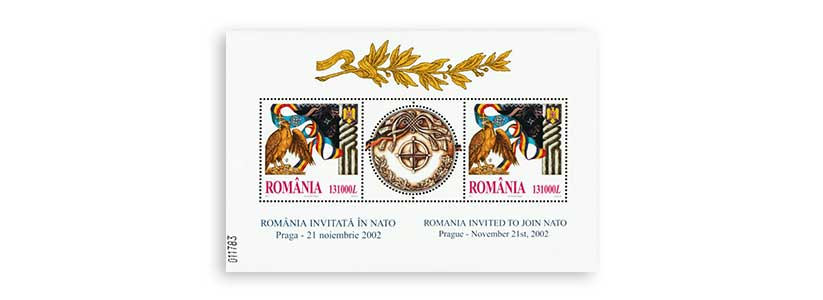
The 2002 Prague Summit was also a significant milestone for NATO, because Allied Leaders agreed to begin accession talks with seven countries that aspired to join the Alliance. One of the seven countries, Romania, decided to celebrate this moment with a stamp designed by Octavian Penda. It depicts the Romanian eagle, the country’s coat of arms, and the NATO and Romanian flags entwined.
2004 – Bulgaria, Estonia, Latvia, Lithuania, Romania, Slovakia and Slovenia join NATO
Bulgaria, Estonia, Latvia, Lithuania, Romania, Slovakia and Slovenia joined NATO on 29 March 2004. This round of enlargement, sometimes referred to as the ‘Big Bang’ enlargement, is the largest in NATO’s history to date. Five of the seven new member countries decided to mark the special date by issuing postage stamps.

Bulgaria’s accession stamp shows the national colours from the Bulgarian flag next to the NATO compass. It was designed by Todor Vardjiev.

Estonia’s accession stamp includes the NATO compass and the simple message that Estonia is a member of the Alliance from 2004. It was designed by Lembit Lõhmus.

Romania’s accession stamp shows NATO Headquarters in Brussels, with Allied flags in the background and the Romanian flag – which would soon join them – in the foreground.

Slovakia’s accession stamp, designed by Ivan Schurmann, features the NATO compass and the national coat of arms from the Slovak flag, which shows a cross over three mountains.

Slovenia’s accession stamp depicts the NATO compass, along with the Alliance’s name and the country’s name. It also includes a small post horn in the bottom right corner, a frequent symbol of national postal services, because these instruments were traditionally used to announce the arrival of a post carrier.
2004 – Fifth anniversary of KFOR
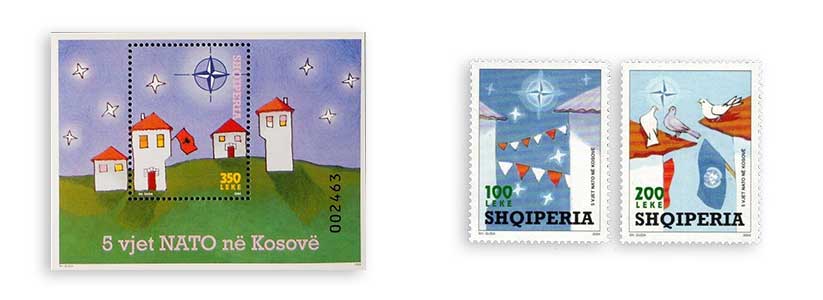
To mark the fifth anniversary of the Kosovo Force – NATO’s UN-mandated peace-support operation in Kosovo – Albania produced a series of stamps that feature the NATO compass as a star in the sky. The stamps also include the Albanian and UN flags, and images of doves as symbols of peace.
2006 – Latvia hosts the Riga Summit

Latvia produced its first NATO stamp in 2006 when it hosted a NATO summit in Riga. The Summit Task Force organised a nationwide competition for the summit logo design and 148 ideas were submitted. From a list of finalists, NATO Secretary General Jaap de Hoop Scheffer chose the proposal of Latvian artist Uldis Freimanis as the winning entry, which features the skyline of the country’s capital city.
2008 – Romania hosts the Bucharest Summit
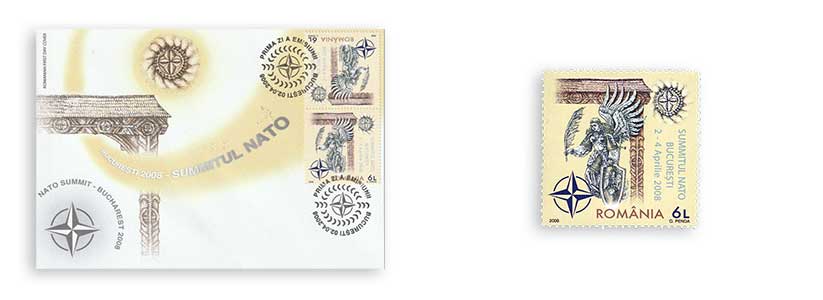
Romania hosted a NATO summit in Bucharest in April 2008. To commemorate this event, the Romanian postal service created a stamp depicting a warrior angel standing in front of a gate. The angel has a sword by her side, but notably is holding a shield and a quill, to represent the defensive nature of the Alliance and the importance of diplomacy. The NATO compass logo is whimsically rendered in seashells at the top right. The stamp was designed by Octavian Penda.
2009 – Albania and Croatia join NATO
Albania and Croatia joined NATO on 1 April 2009.

Albania produced two stamp designs to commemorate this event; one of them features the flags of the then-28 NATO Allies, and the other portrays the two-headed eagle of the Albanian coat of arms alongside the NATO compass. These stamps were actually issued in 2008, when Albania began its accession talks with NATO.

Croatia’s accession stamp shows a map view of its territory rendered in various shades of green, reminiscent of military camouflage. It was designed by Igor Kuduz.

Shortly after accession, Albania produced a series of stamps designed by Renald Vrapi showing its peacekeeping troops under a NATO banner.
2014 – Lithuania and Romania’s 10th anniversary of NATO membership

Designed by Ruta Kajackaite, the stamp produced for Lithuania’s 10th anniversary as a NATO member features a 3D-rendered NATO compass.
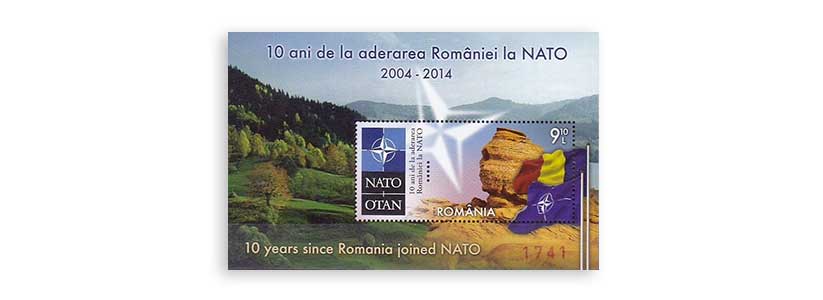
Romania’s 10th anniversary stamp features Romanian nature landscapes, focusing on a natural rock formation called The Sphinx, which is located in the Bucegi Mountains of Romania.
2016 – Poland hosts the Warsaw Summit

To commemorate the 2016 NATO Summit in Warsaw, Poland produced a colourful postage stamp. Designed by Agata Tobolczyk, the stamp depicts Castle Square in Warsaw’s Old Town, showing diverse people on the city’s streets.
2016 – NATO moves to new headquarters in Brussels

As NATO moved to its new headquarters building in Brussels in October 2016 (across the street from the previous headquarters, which was erected in 1967), the Belgian Post issued a commemorative stamp designed by Kris Maes, depicting the new building and its distinctive architecture. Stamp collecters were given the opportunity to purchase this collector’s item. Read more about the stamp’s unveiling in 2016.
2017 – Montenegro joins NATO

Montenegro joined NATO on 5 June 2017. To mark this special date, the country’s postal service issued a stamp designed by Zoran Popović. It combines NATO’s iconic blue and compass with the red background and national coat of arms from Montenegro’s flag. More than 50,000 copies were issued.
2019 – NATO’s 70th anniversary

For NATO’s 70th anniversary in 2019, partner country Georgia developed a stamp combining the number 70 with the NATO compass.

North Macedonia – which was then a partner country and would become a NATO member a year later – also marked the anniversary with a special stamp featuring Allied flags and the 70th anniversary logo.
2019 – Bulgaria’s 15th anniversary of NATO membership

Bulgaria produced a stamp in 2019 to mark its 15th anniversary of NATO membership. The stamp, designed by Nikolay Mladenov, includes an olive branch to symbolise peace, and the iconic Trabant 601 – the car model used by Bulgarian Foreign Minister Solomon Passy to drive NATO Secretary General Manfred Wörner during his first official visit to Bulgaria in 1991. This event became an interesting anecdote in the Alliance’s enlargement history, and today a ‘Trabi’ replica is on permanent display at NATO Headquarters in Brussels, Belgium.
2019 – Croatia’s 10th anniversary of NATO membership

In April 2019, the Croatian Post produced a commemorative stamp to mark the 10th anniversary of the country’s accession to NATO. Created by Marko Jovanovac and Ante Vekić, the design features a stylised combination of NATO’s official logo and the checkerboard design on Croatia’s flag. Over 100,000 stamps were printed by the national post.
2020 – North Macedonia joins NATO

When North Macedonia joined the Alliance in 2020, the country’s national post issued a commemorative stamp featuring the official NATO logo and the national flag. Designed by Larisa Zivkovska Donev, more than 6,000 copies of the stamp were issued in that year.
2022 – Spain’s 40th anniversary of NATO membership

As Spain celebrated 40 years of NATO membership, the country hosted the 2022 NATO Summit in its capital, Madrid. A special stamp was produced using the official logo of the landmark summit, during which NATO Heads of State and Government agreed a new Strategic Concept to guide NATO over the next decade.
2023 – Finland joins NATO

On the occasion of Finland’s accession to NATO in 2023, the national postal service commissioned Finnish artist Ilkka Kärkkäinen to create a commemorative stamp. It features the outline of Finland’s borders, as well as the national colours of each of the country’s new Allies.

Estonia also produced a Finland accession stamp to welcome its northern neighbour into NATO. Designed by Jaan Saar, the Estonian stamp shows Finland in NATO blue, with a NATO compass superimposed over the country. The message is unmistakeable: Finland is NATO territory.
2023 – Lithuania hosts the Vilnius Summit

Lithuania hosted the 2023 NATO Summit in Vilnius. Designer Augustina Lubė created a stamp for the national postal service to mark the occasion. It features the NATO logo alongside a stylised representation of Vytis, the armoured knight that has served as Lithuania's national coat of arms since the late 1300s.
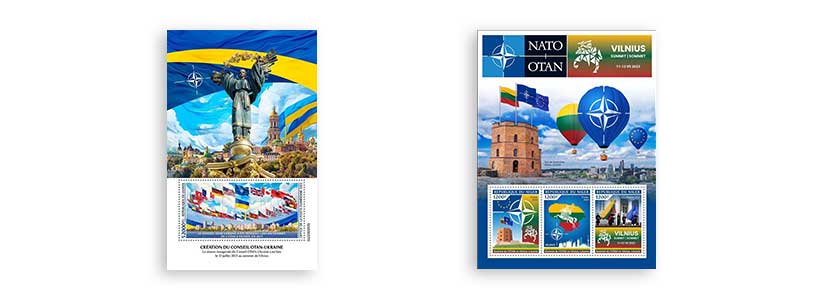
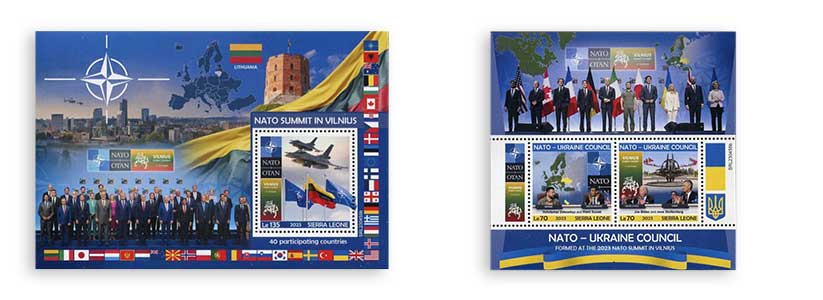
Curiously, a number of countries in Africa also appear to have created stamps to mark the Vilnius Summit, including Guinea (top left), Niger (top right) and Sierra Leone (bottom). These stamps also marked the creation of the NATO-Ukraine Council, one of the key outcomes of the Vilnius Summit.
2024 – Sweden joins NATO

To celebrate Sweden’s accession to NATO on 7 March 2024, the Finnish postal service created a stamp combining the Swedish and NATO flags. The stamp was designed by Anssi Kähärä.
2024 – NATO’s 75th anniversary and Allied accession anniversaries
In 2024, NATO celebrated its 75th anniversary. At the same time, a large number of NATO Allies celebrated milestone accession anniversaries. Depending on the round of enlargement in which a country joined NATO, there were celebrations for their 15th, 20th, 25th and 75th anniversaries in the Alliance.
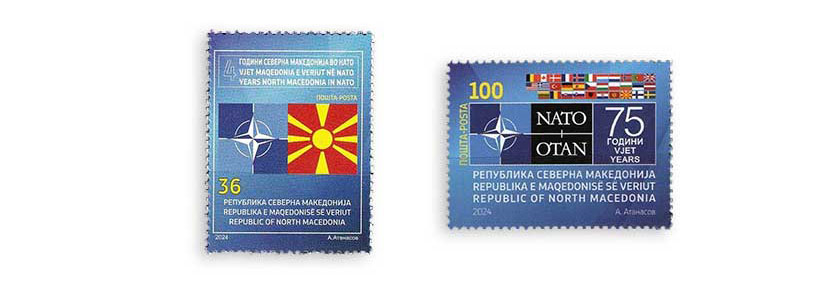
North Macedonia issued two stamps, one celebrating its 4th anniversary in NATO (left) and one celebrating the Alliance’s 75th anniversary (right). The stamps include the NATO compass, North Macedonia’s flag, the flags of all 32 NATO Allies and the NATO 75th anniversary logo.

Croatia’s 15th anniversary stamp, designed by Duje Šegvić, echoes the country’s 10th anniversary stamp from 2019 by combining the NATO compass with the red-and-white checkerboard from Croatia’s flag.

Latvian designer Ģirts Grīva produced a simple design for the country’s 20th anniversary of NATO accession, including the NATO compass on a blue background.

Romania’s 20th anniversary stamp shows the Romanian and NATO flags, along with a stylised ‘20’ that includes the colours of both. It was designed by Mihail Vămășescu.
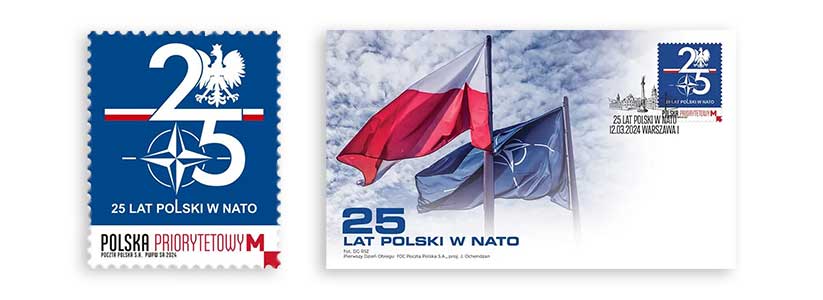
Designed by Jarosław Ochendzan, Poland’s 25th anniversary stamp includes the NATO compass, a crowned eagle from the Polish coat of arms, the Polish national colours, and a stylised ‘25’ to mark the milestone.

Designed by Bianca Becker and Peter Kohl, Germany’s 75th anniversary stamp echoes the clean design of the country’s 50th anniversary stamp in 1999. In addition to “75 years”, it also features the words “secure peace”.

Luxembourg’s 75th anniversary stamp features a stark depiction of the NATO compass in black on a white background, with a small ’75 years’ in Luxembourgish in the lower left corner.
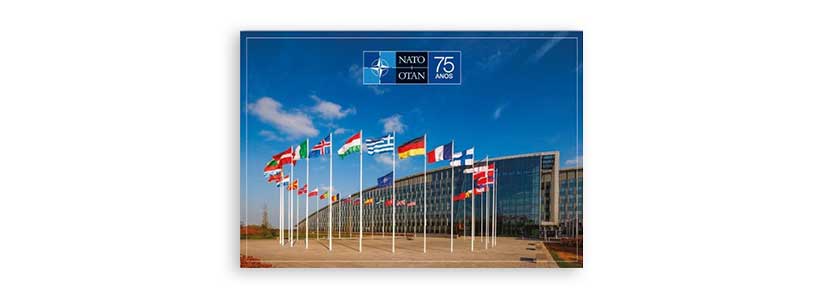
Portugal commemorated the Alliance’s 75th anniversary with a stamp showing the national flags of the 32 NATO Allies in front of NATO Headquarters in Brussels.
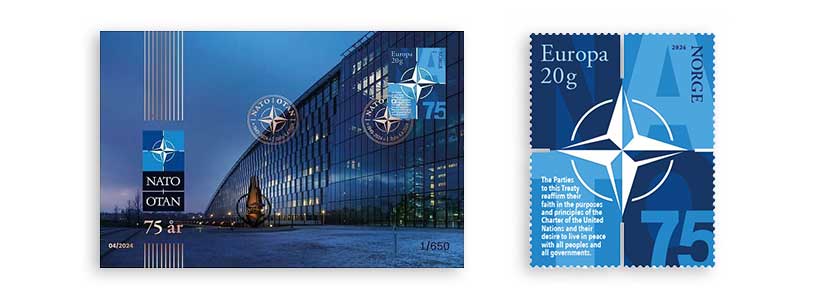
Norway’s 75th anniversary stamp, designed by Camilla Kvien Jensen, includes the NATO compass, the Alliance’s name and a large ‘75’, all in NATO blue. It is the only stamp to include text from the Alliance’s founding treaty, quoting the North Atlantic Treaty’s opening sentence:
“The Parties to this Treaty reaffirm their faith in the purposes and principles of the Charter of the United Nations and their desire to live in peace with all peoples and all governments.”
